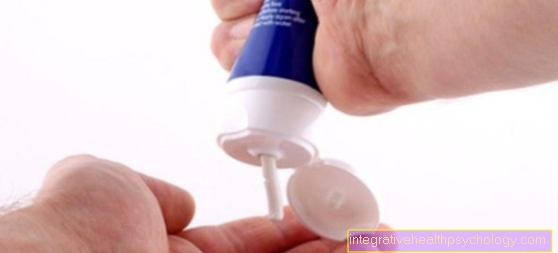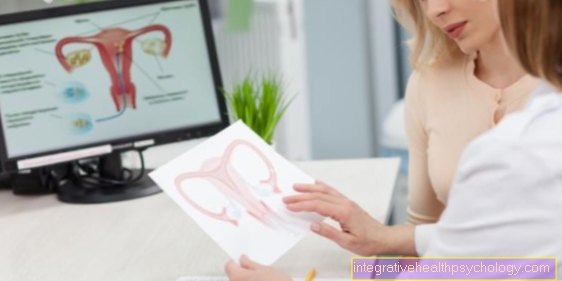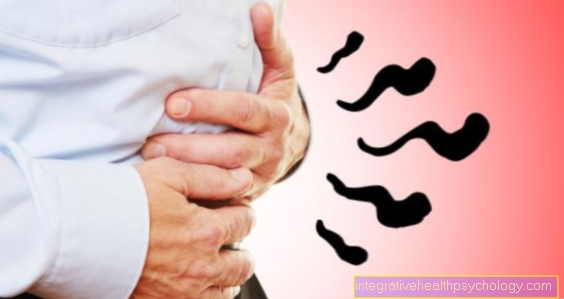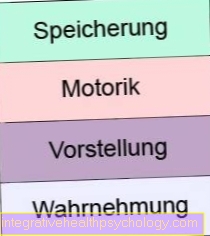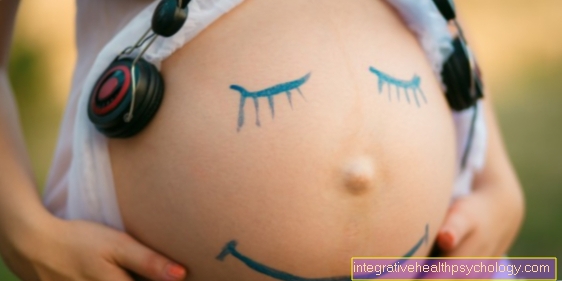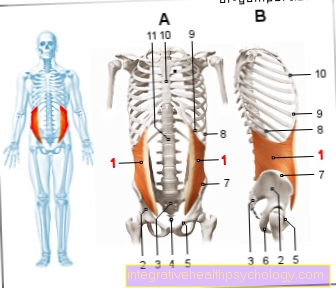Connective tissue pain
causes
In many cases, remodeling processes of the connective tissue are responsible for the development of chronic pain. The connective tissue represents a large network of our body. In addition to the entire muscular system, it also covers the bones, nerve bundles and organs in our body and thus embodies an all-encompassing, coherent connection. The connective tissue enables the human body to move freely. It ensures that all organs stay in their intended place and are able to move smoothly. Nevertheless, it ensures that the organs can move if necessary. In this way, the lungs can expand when inhaled without putting pressure on other organs.
Just like the muscles, the connective tissue is able to contract and cramp. There are many different causes that cause the connective tissue to contract and cramp.
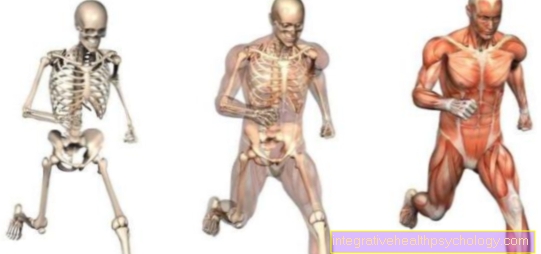
Lack of movement, enormous physical exertion, operations, trauma, overstretching or even stress can lead to a significant restriction in mobility. The connective tissue shortens, becomes sticky, stiff and hard. This is due to the fact that, due to the lack of exercise, water is withdrawn from the connective tissue, which dries out and constricts the surrounding tissue.
Remodeling processes begin, which lead to the fact that the freely moving, elastic fibers are exchanged for rigid, less stretchable, collagen-containing fibers. As a result, there is an increased basic tension in the tissue, which can impair the mobility of the joints and cause pain. The pain often has a burning character and cannot be localized selectively, but rather spreads over an area. The pain occurs not only when moving, but also occurs in many cases predominantly during periods of rest.
Since the connective tissue spreads like a network throughout the body, tension can be passed on to all areas of our body. An acquired misalignment of the arm or shoulder can lead to chronic pain in the neck area. Over time, the tension can also spread to the internal organs and be transmitted. If the connective tissue, which represents a shell for the organs, hardens, the organs are no longer able to absorb important nutrients and to release the accumulating pollutants in sufficient quantities.
Read more about the topic here:
- Inflammation of the connective tissue
- Fascia - function, damage, pain management
pain in the back
pain in the back arise not only as a result of Accidents or degenerative changes. In most cases, the cause is a pronounced lack of exercise and the resulting stiffening and tension. The individual compartments of the back muscles are covered by so-called fascia. Fasciae are bundles of connective tissue that envelop the muscles, pull them through them and play an important role in elasticity and mobility. In addition, these bundles of connective tissue are interconnected and provide important support for the back muscles.
If there is insufficient physical exercise or if the muscles in the back are stressed, the fibers of the connective tissue lose their ability to stretch and become rigid and firm. The Connective tissue sticks together and can therefore no longer guarantee smooth and painless gliding of the muscles in the course of movement. In addition, the nerve cords that run in the area of the back muscles can be severely narrowed and cause pain. The pain is usually extensive and difficult to localize. Especially in the case of back pain, for which no cause can be found on an X-ray, one should always think about the complaints caused by the Connective tissue bundles (fascia) go out. The stiffening and immobility of the connective tissue fibers can over time lead to a chronic shortening of the lower back muscles, which can be associated with permanent lower back pain.
Pain in the thigh
In the field of Thigh pulling pains often occur, which can increase depending on the movement and strain. Often they are not limited to the thigh, but radiate to the hip or knee joint and lead there Joint mobility restrictions. In most cases, the pain occurs either after excessive exertion in the form of sore muscles, or after a long period of immobilization or lack of exercise. The cause of the pain is often tense muscles, tense fascia around the muscles, or the tense connective tissue of the skin on the muscles.
These tensions cannot be easily released and if they persist for a long time they can lead to a shortening and stiffening of the thigh muscles. The affected thigh often feels very tight and hard on the outside. The pain can occur in any area of the thigh. Depending on where they are located, other areas of the connective tissue are affected and seen as the cause of the pain. Often times, a tingling sensation can also arise.
Pain in the abdominal wall
Processes in the area of the connective tissue can also lead to uncomfortable and protracted pain in the abdomen. The internal organs, like the muscles of our body, are covered by connective tissue (Fascia) surround. The so-called peritoneum is one of the fascia in the abdomen.However, if this connective tissue becomes stuck together and becomes immobile and rigid, the movability and sliding ability of the organs in the abdomen is severely impaired and can cause pain. Patients who complain of persistent, recurring complaints in the area of the abdominal cavity and for whom no cause can be found on the basis of special diagnostics such as ultrasound or laparoscopy, is the Sometimes cause in fascia.
In most cases it is a disorder in the fascia area of a particular abdominal muscle. The rectus muscle is the long, vertical abdominal muscle that is particularly evident when a washboard abdomen is formed. In the event of infections or excessive physical exertion, the lower part of the connective tissue covering the long abdominal muscle can stick together.
The pain that occurs within the connective tissue as a result of these adhesions can have a pulling and burning character and is often difficult to localize. They can also be accompanied by abnormal sensations in the area of the abdominal wall or colic-like pain in the lower abdomen. It is also noticeable that in most cases this pain cannot be relieved by conventional anticonvulsant medication.
Pain after jogging
The connective tissue that surrounds the muscles can not only stick and harden due to insufficient movement, but can also be damaged by excessive or excessive physical activity. Bad posture or overstretching, which can occur when jogging through excessive physical strain, can lead to painful damage to the connective tissue fibers.
The body tries to compensate for a slight overstretching by overloading the muscles. This creates cracks in the connective tissue and inflammatory processes develop, which lead to the fact that you feel a pulling pain after jogging and so-called sore muscles develop. The pain often has a burning and pulling character and is further aggravated by the movement of the affected muscle groups. Sore muscles heal completely within a few days.
The damaged connective tissue still needs some time to regenerate. Most people take a relieving posture because of the pain. Often, however, this only makes the process worse, as the relieving posture creates an overload of the connective tissue in another part of the body, which in turn causes new pain.
Chest pain
Pain caused by connective tissue can also manifest in the chest area. Tension and overstressing of the chest muscles can damage the surrounding connective tissue and cause it to stick, become rigid and contract. This not only creates severe pain, but also tremendous pain Restriction of mobility the chest. Above all, this is a decisive and important turning point in the course of the breathing process.
Since the pain depends on the degree of tension and the mobility of the chest during breathing is not smooth due to the sticking together of the connective tissue, patients often only breathe in to a very limited extent in order to avoid the pain. In many cases, the stabbing pain in the chest also leads to a feeling of fear or oppression, which makes the patient even more insecure and stressful.
therapy
There are several options available for treating pain caused by damage to and adhesion of the connective tissue. If the connective tissue has been glued and contracted for a long time, it is often enough easy movement or light exercises to loosen the hardened structures. The connective tissue and the fasciae can, however, be targeted application of pressure mobilize relatively well at certain points.
As a result, the connective tissue becomes smoother and more mobile, possible abnormal sensations subside and disappear and the muscles that are enveloped by the connective tissue relax and gain freedom of movement. This can be done through a targeted physiotherapy treatment or Massages can be achieved. Also a special, adapted to the complaints, Fascia training is useful for treatment, as light and not very strenuous stretching exercises also relieve tension and contractions and ensure more mobility. Will these exercises Every day repeatedly, this not only ensures better mobility, but also relieves pain in the long term and prevents bad posture and increased immobility. In addition, the patient should be trained so that he can independently recognize bad posture and immediately correct it before remodeling processes occur within the connective tissue.



